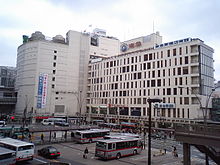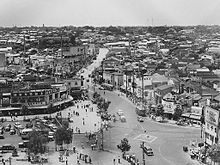Shibuya (Shibuya)
Shibuya ( Japanese 渋 谷 ) is a district of the Shibuya district of the Japanese prefecture of Tokyo . It is located in the southwestern center of Tokyo on the east side of Shibuya Station . With numerous shops, offices and public facilities, it is one of the three large sub-centers ( fuku-toshin ) in western Tokyo alongside Shinjuku and Ikebukuro . It is divided into four numbered quarters, chôme , in which a total of 3,534 inhabitants lived according to the 2005 census, the daily population was 72,447. Colloquially, the districts west of the train station (Sakuragaokachō, Dōgenzaka, Udagawachō), known as the nightlife district, are also counted as Shibuya.
The traffic and commercial center of both the district and the district is the train station, where several subway and private railway lines are connected to the Yamanote line . At the southern end of the station, in front of the Shibuya police station, the three most important main streets of the district meet: the Roppongi-dōri , over which the city freeway No. 3 (Shibuya line) runs, in an east-west direction, and the Meiji-dōri in the north -South direction and the Aoyama-dōri branching off to the northeast . Near the northwest corner of the station, at the Hachikō -guchi ("Hachikō entrance") are numerous department stores, including Seibu , Tōkyū and the 109 opposite the station.
The place name Shibuya has existed since ancient times for the area at the confluence of the Ondengawa and Udagawa rivers to Shibuyagawa near today's train station. With the establishment of modern local authorities in 1889, the village of Shibuya in Minami-Toshima County was created, which was upgraded to a city in 1909. Finally, in 1932, Shibuya was incorporated into the city of Tokyo , where it formed the Shibuya district together with the previous cities of Sendagaya and Yoyohata. By the connection of today's Tōkyū , Keiō and Ginza lines , the station, which opened in 1885, developed into a traffic junction and, beginning with the (Tōkyū) Tōyoko department store station, into a business center until the 1930s . In the post-war period, it continued to develop into a shopping and entertainment district. More recently, IT settlements have formed the so-called Shibuya Bit Valley , especially southwest of the train station .
The post code of Shibuya - the demarcated district in the strict sense - is 150-0002. The current subdivision was created in the 1960s.
Web links
- Shibuya District: History of Shibuya District
Individual evidence
- ↑ Shibuya-ku ("Shibuya District", English Shibuya City ): "Day and night population by district" ( Memento of the original from April 22, 2016 in the Internet Archive ) Info: The archive link was inserted automatically and has not yet been checked. Please check the original and archive link according to the instructions and then remove this notice. (Japanese; MS Excel ; 34 kB)
Coordinates: 35 ° 40 ′ N , 139 ° 42 ′ E


